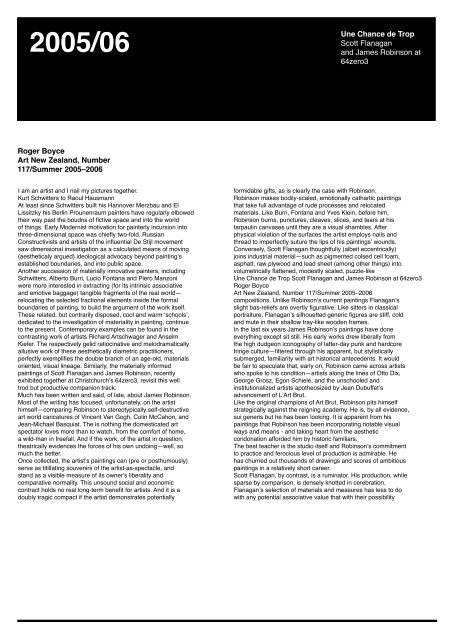Download James Robinson Press Kit - XOGenesis
Download James Robinson Press Kit - XOGenesis
Download James Robinson Press Kit - XOGenesis
You also want an ePaper? Increase the reach of your titles
YUMPU automatically turns print PDFs into web optimized ePapers that Google loves.
2005/06<br />
Roger Boyce<br />
Art New Zealand, Number<br />
117/Summer 2005–2006<br />
I am an artist and I nail my pictures together.<br />
Kurt Schwitters to Raoul Hausmann<br />
At least since Schwitters built his Hannover Merzbau and El<br />
Lissitzky his Berlin Prounenraum painters have regularly elbowed<br />
their way past the boudns of fictive space and into the world<br />
of things. Early Modernist motivation for painterly incursion into<br />
three-dimensional space was chiefly two-fold. Russian<br />
Constructivists and artists of the influential De Stijl movement<br />
saw dimensional investigation as a calculated means of moving<br />
(aestheticaly argued) ideological advocacy beyond painting’s<br />
established boundaries, and into public space.<br />
Another succession of materially innovative painters, including<br />
Schwitters, Alberto Burri, Lucio Fontana and Piero Manzoni<br />
were more interested in extracting (for its intrinsic associative<br />
and emotive baggage) tangible fragments of the real world—<br />
relocating the selected fractional elements inside the formal<br />
boundaries of painting, to build the argument of the work itself.<br />
These related, but contrarily disposed, cool and warm ‘schools’,<br />
dedicated to the investigation of materiality in painting, continue<br />
to the present. Contemporary examples can be found in the<br />
contrasting work of artists Richard Artschwager and Anselm<br />
Kiefer. The respectively gelid ratiocinative and melodramatically<br />
allusive work of these aesthetically diametric practitioners,<br />
perfectly exemplifies the double branch of an age-old, materials<br />
oriented, visual lineage. Similarly, the materially informed<br />
paintings of Scott Flanagan and <strong>James</strong> <strong>Robinson</strong>, recently<br />
exhibited together at Christchurch’s 64zero3, revisit this well<br />
trod but productive companion track.<br />
Much has been written and said, of late, about <strong>James</strong> <strong>Robinson</strong>.<br />
Most of the writing has focused, unfortunately, on the artist<br />
himself—comparing <strong>Robinson</strong> to stereotypically self-destructive<br />
art world caricatures of Vincent Van Gogh, Colin McCahon, and<br />
Jean-Michael Basquiat. The is nothing the domesticated art<br />
spectator loves more than to watch, from the comfort of home,<br />
a wild-man in freefall. And if the work, of the artist in question,<br />
theatrically evidences the forces of his own undoing—well, so<br />
much the better.<br />
Once collected, the artist’s paintings can (pre or posthumously)<br />
serve as titillating souvenirs of the artist-as-spectacle, and<br />
stand as a visible measure of its owner’s liberality and<br />
comparative normality. This unsound social and economic<br />
contract holds no real long-term benefit for artists. And it is a<br />
doubly tragic compact if the artist demonstrates potentially<br />
Une Chance de Trop<br />
Scott Flanagan<br />
and <strong>James</strong> <strong>Robinson</strong> at<br />
64zero3<br />
formidable gifts, as is clearly the case with <strong>Robinson</strong>.<br />
<strong>Robinson</strong> makes bodily-scaled, emotionally cathartic paintings<br />
that take full advantage of rude processes and relocated<br />
materials. Like Burri, Fontana and Yves Klein, before him,<br />
<strong>Robinson</strong> burns, punctures, cleaves, slices, and tears at his<br />
tarpaulin canvases until they are a visual shambles. After<br />
physical violation of the surfaces the artist employs nails and<br />
thread to imperfectly suture the lips of his paintings’ wounds.<br />
Conversely, Scott Flanagan thoughtfully (albeit eccentrically)<br />
joins industrial material—such as pigmented colsed cell foam,<br />
asphalt, raw plywood and lead sheet (among other things) into<br />
volumetrically flattened, modestly scaled, puzzle-like<br />
Une Chance de Trop Scott Flanagan and <strong>James</strong> <strong>Robinson</strong> at 64zero3<br />
Roger Boyce<br />
Art New Zealand, Number 117/Summer 2005–2006<br />
compositions. Unlike <strong>Robinson</strong>’s current paintings Flanagan’s<br />
slight bas-reliefs are overtly figurative. Like sitters in classical<br />
portraiture, Flanagan’s silhouetted generic figures are stiff, cold<br />
and mute in their shallow tray-like wooden frames.<br />
In the last six years <strong>James</strong> <strong>Robinson</strong>’s paintings have done<br />
everything except sit still. His early works drew liberally from<br />
the high dudgeon iconography of latter-day punk and hardcore<br />
fringe culture—filtered through his apparent, but stylistically<br />
submerged, familiarity with art historical antecedents. It would<br />
be fair to speculate that, early on, <strong>Robinson</strong> came across artists<br />
who spoke to his condition—artists along the lines of Otto Dix,<br />
George Grosz, Egon Schiele, and the unschooled and<br />
institutionalized artists apotheosized by Jean Dubuffet’s<br />
advancement of L’Art Brut.<br />
Like the original champions of Art Brut, <strong>Robinson</strong> pits himself<br />
strategically against the reigning academy. He is, by all evidence,<br />
sui generis but he has been looking. It is apparent from his<br />
paintings that <strong>Robinson</strong> has been incorporating notable visual<br />
ways and means - and taking heart from the aesthetic<br />
condonation afforded him by historic familiars.<br />
The best teacher is the studio itself and <strong>Robinson</strong>’s commitment<br />
to practice and ferocious level of production is admirable. He<br />
has churned out thousands of drawings and scores of ambitious<br />
paintings in a relatively short career.<br />
Scott Flanagan, by contrast, is a ruminator. His production, while<br />
sparse by comparison, is densely knotted in cerebration.<br />
Flanagan’s selection of materials and measures has less to do<br />
with any potential associative value that with their possibility


